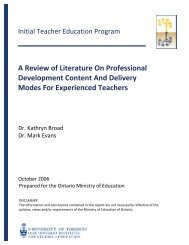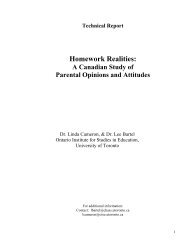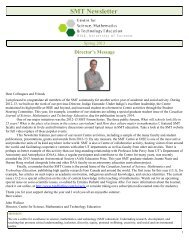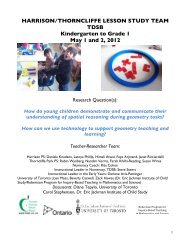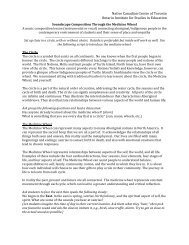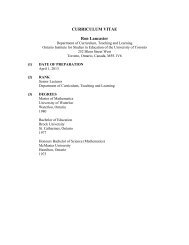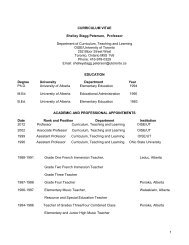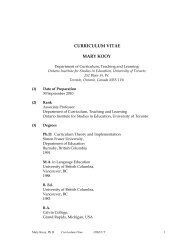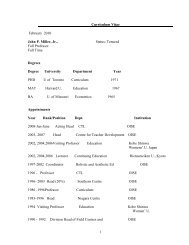The Ontario Curriculum, Grades 9-12 - Ministère de l'éducation ...
The Ontario Curriculum, Grades 9-12 - Ministère de l'éducation ...
The Ontario Curriculum, Grades 9-12 - Ministère de l'éducation ...
Create successful ePaper yourself
Turn your PDF publications into a flip-book with our unique Google optimized e-Paper software.
F. Plants in the Natural Environment<br />
F1. Relating Science to Technology, Society, and the Environment<br />
F1. analyse the roles of plants in ecosystems, and assess the impact of human activities on the<br />
balance of plants within those ecosystems<br />
F1.1 analyse, on the basis of research, and report on ways in which plants can be used to<br />
sustain ecosystems [IP, PR, AI, C]<br />
Sample issue: Urban areas place intense pressure on ecosystems. Some of the negative<br />
impact can be reduced by cultivating urban forests. <strong>The</strong>se green spaces filter air, water,<br />
and sunlight; reduce the “urban heat island” effect; provi<strong>de</strong> habitat for wildlife; and<br />
increase biodiversity. However, many cities do not set asi<strong>de</strong> enough land for green spaces<br />
because of pressures for urban <strong>de</strong>velopment.<br />
Sample questions: What are some of the environmental and economic benefits of building<br />
urban green spaces on large commercial buildings? What role do native plant species in<br />
marshes play in filtering organic waste? How have traditional Aboriginal seed maintenance<br />
and distribution practices helped sustain ecosystems in Aboriginal communities?<br />
F1.2 assess the positive and negative impact of human activities on the natural balance of<br />
plants (e.g., crop rotation, the use of fertilizers and herbici<strong>de</strong>s, the introduction of new<br />
species) [AI, C]<br />
Sample issue: <strong>The</strong> greening of cities with a variety of native plant species helps to<br />
maintain biodiversity, restore natural landscapes, and provi<strong>de</strong> food and habitat for local<br />
wildlife. However, many urban gar<strong>de</strong>ners introduce non-native plants, which can<br />
compete with the native species and may not be hospitable to the local wildlife.<br />
Sample questions: How has increased knowledge about plant growth been applied to<br />
improve the resistance of some plants to pests, and allowed those plants to be used in nonnative<br />
areas? What are the positive and negative effects of such applications? In what ways<br />
does monoculture affect the natural balance of plants and the ecosystems they help sustain?<br />
F2. Developing Skills of Investigation and Communication<br />
F2. investigate some of the factors that affect plant growth<br />
F2.1 use appropriate terminology related to plants in the environment, including, but not<br />
limited to: xylem, phloem, chloroplast, pistil, stamen, nitrogen fixation, and tropism [C]<br />
F2.3 investigate how chemical compounds (e.g., fertilizers, herbici<strong>de</strong>s, pestici<strong>de</strong>s) and<br />
physical factors (e.g., amount of sun and water, quality of soil, pH of soil) affect plant<br />
growth [PR, AI]<br />
F2.4 investigate plant tropism by growing and observing plants in a variety of natural and<br />
human-ma<strong>de</strong> environments [PR]<br />
F3. Un<strong>de</strong>rstanding Basic Concepts<br />
F3. <strong>de</strong>monstrate an un<strong>de</strong>rstanding of the structure and physiology of plants and their role in<br />
the natural environment<br />
F3.4 explain the various roles of plants in the sustainability of the natural environment (e.g., in<br />
nutrient cycles, in the water cycle, in erosion control, in wildlife habitats)<br />
Science 115



